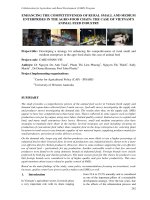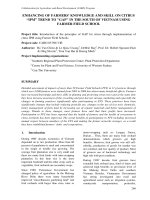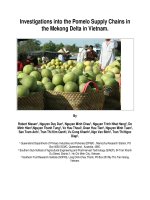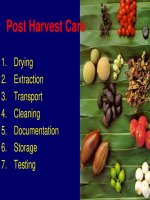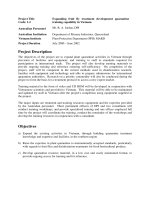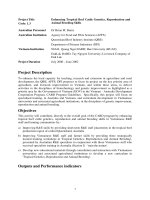Báo cáo nghiên cứu nông nghiệp " Increasing the capacity of the Food Crops Research Institute to enhance the Production and Management of Potatoes in the Red River Delta " pot
Bạn đang xem bản rút gọn của tài liệu. Xem và tải ngay bản đầy đủ của tài liệu tại đây (108.02 KB, 12 trang )
Project Title
Code: 1.7
Increasing the capacity of the Food Crops Research
Institute to enhance the Production and Management
of Potatoes in the Red River Delta
Australian Personnel
Paul Mattingley / Peter Batt
Australian Institution
Agriculture Western Australia / Curtin University
Vietnam Institution
Food Crops Research Institute
Project Duration
July 2000 to June 2002
Project Description
This project aims to increase the productivity and profitability of potato production in
the Red River Delta (RRD) through an integrated crop production and marketing
program. The project is a co-operative research and extension program between the
Food Crops Research Institute (FCRI), Agriculture Western Australia and Curtin
University. Improvements in productivity and net returns will be achieved by training
Vietnamese agronomists and extension agents in the methodologies used by the potato
industry in Western Australia (WA).
Objectives
a) The overall objective is to increase the productivity and profitability of potato
production through an integrated crop production and marketing program. The
project is a co-operative research and extension program. Improvements in
productivity and net returns will be achieved by training Vietnamese agronomists in
the methodologies used by the potato industry in WA.
b) Integrated crop management involves developing an understanding of the most
important factors that effect the performance of a crop. It also involves the
development of an understanding of the interactions between these factors. Crop
improvement will occur through advances in agronomy, post harvest storage of
product, improved seed production and genetic improvements. To achieve the
major objective, the following objectives must be met:
♦ To train FCRI staff to identify the major factors limiting production
♦ To train FCRI staff to identify improved agronomic inputs that will increase
marketable yields.
♦ To train FRCI staff to identify improved storage techniques that will increase
profits to growers.
♦ To demonstrate potato growers in the RRD an improved seed supply scheme of
improved varieties.
♦ To improve profits to growers through adoption of improved varieties (genetic
improvement).
♦ To improve farmers and FCRI staff understanding of the dynamics of both
domestic and export markets and the various means farmers have of collectively
manipulating the supply of potatoes (and prices) to the market.
Outputs and Performance indicators
Outputs
Performance Indicators
♦ Survey of crops in the first year will achieve the i) Publication of survey results of
objective of training FCRI staff to identify the major
factors limiting production
crops in the RRD
♦ Experiments will be conducted in the second year to i) Publication of recommendations
developed from the agronomy trials.
develop improved agronomic inputs that will
overcome the limiting factors identified in the crop
survey. This will achieve the objective of training
FCRI staff how to identify improved agronomic
inputs that will increase marketable yields.
♦ The quality of tubers for seed and for sale will be i) The completion of storage trials that
will increase the storage period of
improved through post harvest work. This will
marketable tubers and reduce the
achieve the objective of training FCRI staff to
concomitant storage losses.
investigate improved storage techniques to increase
profits to farmers.
♦ An improved method of supplying seed tubers to the i) The increased yield of crops planted
in the first field generation.
RRD will be demonstrated. This will involve the
importation of high quality seed in the RRD and the
final bulking by ordinary growers. This will
achieve the objective of demonstrating an improved
seed scheme that offers farmers healthy seed of
vegetatively propagated potato varieties.
♦ Improved varieties developed by the FCRI will be ii) The performance indicator will be
the amount of new varieties ordered
tested on a commercial scale for the first time. High
in March 2002
quality seed of these new varieties will be supplied
from WA seed specialists. This will achieve the
objective of improving profits to growers through
the adoption of improved varieties.
♦ The understanding of agricultural marketing iii) Development of business plans by
local groups incorporating a
systems by both potato growers and FCRI staff will
marketing strategy and possible
improve the various means growers have of
development of export markets.
collectively manipulating the supply of potatoes
(and prices). This will improve profits to growers,
ensuring that the increased production is marketed
effectively, rather leading to an oversupply and
commensurate price reduction.
2
PROJECT COMPLETION REPORT
Executive summary
The project is a collaborative research and development project focusing on improving
the potato production system in the Red River Delta in Vietnam. The Department of
Agriculture, Western Australia (DAWA), Curtin University and the Food Crops
Research Institute (FCRI) in Vietnam worked to develop the capacity of the FCRI in a
number of key areas: crop management, variety evaluation, agronomy profiling, post
harvest and marketing. The project has demonstrated the benefits of using high quality
seed of Vietnamese varieties and has shown how this can form the basis of an improved
seed scheme from which growers in the Red River Delta (RRD) can improve their
yields, profits and livelihoods. Adoption of BMP resulted in a 20 to 40 per cent
increase in marketable yield of local varieties TK51.6 and KT3 compared with the
normal practices of growers. Adoption of BMP resulted big increases in gross margins
for the farmers in the Red River Delta. For example for the variety TK51.6 gross
margins were on average 140 per cent (ie $880 v $1753 /ha) higher and 80 per cent
higher for variety KT3 ($2030 v $3444/ha) compared with normal grower practice.
This highlights the importance of growers using best management practices to maximise
returns when investing in high quality seed.
1. Project description
1.1 Background and preparation
It is widely recognised that the absence of a high quality, pathogen free seed of the
desired physiological age is the major constraint limiting the expansion of the potato
industry in South East Asia. For many years the International Potato Centre (CIP) has
been breeding potato varieties that are more suited to the tropics. However, these new
varieties have not been adopted because of the lack of sufficient quantities of high
quality seed.
In 1995, WA hosted representatives of the National Potato Programs from Vietnam and
the Philippines, the CIP and SAPPRAD to further investigate opportunities to develop
relationships with the potato industries of South East Asia.
In 1996 the WA Potato Marketing Corporation submitted a proposal to AusAID under
the AAECP Linkages III program. This proposal was to test the performance of CIP
varieties by first importing pathogen free foundation material into Australia, for
subsequent multiplication and re export to Vietnam. The results of this work were
encouraging with Vietnamese developed varieties performing very well. The Project
team then developed the current CARD project to build upon this work, further trialing
Vietnamese varieties, demonstrating the potential of this new seed system and providing
technical support in the form of crop management, post harvest and marketing to
optimise the output of the proposed system.
1.2 Context and rationale
Potatoes have been classified a priority crop in the RRD by the Government of
Vietnam: they provide an alternative to rice and are capable of feeding an expanding
population. Potato production in Vietnam is centred around the Red River Delta where
32,000 ha are cultivated. In the early 1980s approx. 100,000 ha of potatoes were
cultivated in the RRD, this figure has since fallen, due to the poor quality of seed and
the lack of an integrated crop management system leading to low yields of 10-12
tonnes/ha. The FCRI estimated there is the potential to grow 400,000 ha of potatoes in
the RRD should yields prove economical. Ultimately the profitability of growing
potatoes will be determined by the farmers’ ability to produce and store the product and
control the volumes of tubers despatched to the market.
Most (approx.10,000 tonnes) of the seed used in the Red River Delta comes from China,
the seed being small tubers graded out of the ware crop. The seed from China tends to
be mixture of varieties and suffers with various bacterial, fungal and viral diseases
including powdery scab. It is used because it is cheap and has been recently harvested,
whereas Vietnamese seed is often stored for 9 months between seasons prior to use.
The Vietnamese potato industry needs high quality seed of varieties that are most suited
to their growing conditions. Accordingly this project has aimed to introduce an
alternative source of seed, developed specifically for the RRD’s tropical conditions by
the FCRI plant breeding team, and bulked up to commercial quantities in Western
Australia.
1.3 Project objectives and scope at design
The overall objective of the project has been to increase the productivity and
profitability of potato production through an integrated crop production and marketing
program.
To support this objective a series of activities were undertaken focusing on developing
the capacity of FCRI and growers to effectively manage crop production, storage and
marketing. The project design included the following activities:
•
Training FCRI staff to identify the major factors limiting production.
•
Training FCRI staff to identify improved agronomic inputs that will increase
marketable yields.
•
Training FCRI staff to identify improved storage techniques that will increase
profits to growers.
•
Demonstration to potato growers in the RRD of an improved seed supply scheme
of improved varieties.
•
Improve profits to growers through adoption of improved varieties (genetic
improvement).
•
Improve farmers and FCRI staff understanding of the dynamics of both domestic
and export markets and the various means farmers have of collectively
manipulating the supply of potatoes (and prices) to the market.
The hands-on nature of most the research and development work has been very
successful in ensuring that FCRI staff and potato growers have developed new skills.
The ‘learning by doing’ style of the project ensuring that skills demonstrated by the
WADA and Curtin University staff are evaluated, customised and incorporated into
FCRI and grower practices.
The project has addressed a number of key issues for both AusAID and the Vietnamese
government assisting in developing R & D capacity in a crop which provides valuable
nutrition, employment and income for the poor farmers of the RRD.
1.4 Implementation arrangements
The project has been managed by the WADA, with the Dept and Curtin University
providing short term inputs to develop the capacity of the Vietnamese counterpart – the
4
FCRI. The project partners had worked together previously on a AAECP project and
have continued to develop a good working relationship. The management of the project
has been assisted greatly by having 2 Youth Ambassadors seconded from the WADA,
Joanna Embry and Ashe Briscoe, who spent a total of 21 months working in Hai Duong
with the FCRI.
2. Appropriateness of project design and objectives
2.1
Appropriateness of objectives
Objective
No./Ref.
Objective description
2.2.1
Crop Survey to train FCRI staff in identifying the major
factors limiting production.
5
2.2.2
Training FCRI staff to identify improved agronomic inputs
that will improve yields.
5
2.2.3.0
To train FCRI staff to identify improved storage techniques
for both seed and ware potatoes that will increase profits to
growers.
5
2.2.3.1
To assist staff to develop a survey instrument which will
identify the importance of problems experienced in
postharvest handling of seed and ware potatoes on the Red
River Delta.
4
2.2.3.2
To identifying the training needs of FCRI staff and
personnel in co-operatives collaborating with the FCRI in
postharvest technology of seed and ware potatoes.
5
2.2.3.3
To identify possible research projects on alternative
methods of extending the shelf life of seed and ware
potatoes in storage.
5
2.2.4
To demonstrate to potato growers in the RRD an improved
seed supply scheme of improved varieties
5
2.2.5
To commercially test improved potato varieties developed
by the FCRI.
5
2.2.6
To develop FCRI staff and grower understanding of
marketing to capture the benefits of increased production.
4
2.2
Appropriateness
rating
Appropriateness of design
Appropriateness
rating
Survey of grower practices with stratified cluster sampling and
5
multiple regression analysis of relationships
Planning, implementation and analysis of the agronomy trials
5
based on the results of survey.
With FCRI staff visit Ministry of Agriculture personnel, research
5
institutes scientists, co-operatives and farmers in the target area to
discuss their experience with the storage of seed and ware potatoes.
Inspect storage facilities in the provinces under study
5
Description of design features
2.2.1
2.2.2
2.2.3
2.2.3
2.2.3 Inspect seed about to be planted to identify storage problems
experienced by farmers and co-operatives
2.2.3 Finalise a survey instrument with FCRI staff, which will assist in
defining the problem, experienced in seed storage by farmers and
establish research priorities.
2.2.3 Use the above information to develop training and research
activities
2.2.4 Improved techniques for seed production.
Mother
seed
produced
for
Vietnam
in
WA
Specialist Vietnamese growers to bulk seed in Vietnam
Positive plant selection.
2.2.5 Genetic Improvements
Supply the improved FCRI developed varieties KT3 &
VC51.6 using high quality WA seed.
2.2.6 Marketing - Explore existing supply chain relationships for the
various market segments and identifying possible improvements.
The findings of this research were then incorporated into
developing appropriate training workshops.
5
4
4
5
4
1
5
4
3. Implementation performance
3.1
Project components and outputs
Component
No.
2.2.1
2.2.2
Recommendations
for improved crop
production.
2.2.3.0
Post
harvest
technology
to
extend storage and
to reduce losses
2.2.3.1
Post
harvest
technology
to
extend storage and
to reduce losses
2.2.3.2
6
Component
description
Identification
of
major
factors
limiting
marketable yield.
Post
harvest
technology
to
extend storage and
Performance
Performance
indicators
rating
Crop Survey to train Publication
of
5
FCRI
staff
in survey results of
identifying
the crops in the RRD
major
factors
limiting production.
Training FCRI staff Publication
of
5
to identify improved recommendations
agronomic
inputs developed from
that will improve the
agronomy
yields.
trials
Train FCRI staff to The completion
5
identify improved of storage trials
storage techniques that will increase
for both seed and the storage period
ware potatoes that for
marketable
will increase profits tubers and reduce
to growers.
concomitant
storage losses.
Assist
staff
to Publication
of
4
develop a survey options
for
instrument that will survey
identify
the instruments
to
importance
of identify
post
problems
harvest problems
experienced
in
postharvest handling
of seed and ware
potatoes on the Red
River Delta.
Identify the training Development of
5
needs of FCRI staff training plan
and personnel in coOutputs
to reduce losses
2.2.3.3
Post
harvest
technology
to
extend storage and
to reduce losses
2.2.4
Improved
techniques for seed
production
2.2.5
Genetic
improvements
2.2.6
Potato Marketing
operatives
collaborating with
the
FCRI
in
postharvest
technology of seed
and ware potatoes.
Identify
possible
research projects on
alternative methods
of extending the
shelf life of seed and
ware potatoes in
storage.
Demonstrate
to
potato growers in
the
RRD
an
improved
seed
supply scheme of
improved varieties.
Commercially test
improved
potato
varieties developed
by the FCRI
Develop FCRI staff
and
grower
understanding
of
marketing to capture
the
benefits
of
increased
production.
If research results
are positive then
proposals
for
research projects
will be developed
4
The performance
indicator will be
the amount of
new varieties in
use.
5
Publication
of
test
results
comparing
improved
and
traditional potato
varieties
Development of
business plans by
local
groups
incorporating a
marketing
strategy
and
possible
development of
export markets
5
A number of changes were approved through the course of the project, these are
detailed in Annexes 2, 3 and 4. The main changes being:
Study tour by Vietnamese researchers and growers to Western Australia. The aim of
the tour was to demonstrate specialist seed potato growers operating within a
functioning seed certification scheme. In this way growers and researchers could see
the potential for to develop a seed certification scheme appropriate for Vietnam. In
addition the Vietnamese team gained an insight into marketing of ware, processed and
seed potatoes as well as best management practices and the co-ordination achieved
between industry and government.
Focus on marketing and economics - further work was carried out in the area of
economics and marketing. As production is predominantly around the Tet Holiday
(Lunar New Year) there is the possibility of over-supply leading to reduced grower
prices. To overcome this further work was undertaken by Peter Batt looking at the
supply chain to measure the elasticity of supply and demand. In addition workshops
were conducted to improve researcher and grower understanding of market dynamics.
This work has also been supported by inputs from Western Australian exporters, Youth
Ambassadors and the recent study tour visit to Western Australia.
Integration of research results into the wider potato program - To ensure that the
results of the R&D work are effectively communicated through MARD, Terry Hill,
Program Manager from the WADA, visited Vietnam. His work focusing on ensuring
4
that systems are in place to capture, retain and disseminate project information
throughout MARD.
Best Practice trials - The project was extended into a third year, the main aim being to
ensure that the findings of the project, particularly those related to crop management,
were demonstrated to growers and other researchers. The work indicating the problems
caused by low levels of potassium and the benefits of using cut seed, cool stored and
treated with cement or mancozeb was very important to the Vietnamese potato industry.
3.2 Project outcomes
The project has been successful in delivery training to FCRI staff and growers in a
number of key areas:
Crop survey (2.2.1) and the surveys undertaken with Joanna Embry (Farm financial
performance), Peter Batt (Marketing) and John Janes (Postharvest) provided
counterparts with key skills in survey design, implementation (interviews and data
collection) and analysis. These skills will prove extremely useful in future research and
extension work.
Cut seed - The benefits of using cut seed were effectively demonstrated to the growing
community through agronomic trials, best practice trials, hands-on workshop training
provided by Western Australian farmer, Tom Fox and the recent WA study tour. Using
cool stored cut seed will reduce input costs whilst maintaining yields, so reducing the
financial exposure faced by growers buying in high quality seed.
Post harvest - Surveys undertaken by the Post harvest specialist indicate that field and
storage hygiene are inadequate to control diseases being spread by seed produced and
stored by farmers. A major training program supported by legislation to set up a clean
seed certification system is required. The seed certification system needs cool stores to
function effectively and cool stores will replace diffuse light storage in houses as a
means of storing seed tubers.
Marketing - A comprehensive study of the supply chain was undertaken and this
provided the impetus for further work in this area funded by a German aid project
(GTZ). In addition to workshops, growers and researchers have learnt more on the
marketing of ware, processed and seed potatoes through visits by WA exporters and
through the study tour to WA. Here growers saw seed potatoes specifically grown and
marketed through a regulated system.
Variety evaluation - Vietnamese varieties had initially been evaluated under the
AAECP project. During the CARD Project further varieties were evaluated. Of those
TK51.6, Eben and KT3 in particular performed well. These varieties having good yield
potential, yield stability over locations and seasons, and dry matter content. Therefore,
they are recommended for rapid multiplication for production. These clones may also
be suitable for processing as they further have low concentration of reducing sugars.
TK51.6 has a short dormancy period, thus low storability under the ambient hot and
humid conditions of the diffused light storage that is the most popular seed storage
method used by the farmers in Vietnam. That said, all clones will only reach their
potential if they are stored in cool rooms between seasons.
3.3 Sectoral impact
Potato production in the RRD relies heavily on women carrying out much of the work,
often as a result of male rural-urban drift. The project has effectively targeted women
with new techniques and ideas in the areas of crop management, storage and cutting of
8
large tubers for seed. A number of female researchers at the FCRI have received
training including Ms Nguyen Thi Hue, Mrs Nguyen Thi Que and Ms Hoai. In addition
the project has benefited greatly from the presence of 2 female Youth Ambassadors who
have developed a good working relationship with the staff at FCRI and the growing
community.
3.4 Costs and financing
Revisions to the project budget has enabled the project to be extended to 3 seasons.
Annexes 2, 3 and 4 detail these changes. The project was carried out with considerable
savings being made from the use of soil and plant analysis facilities in Vietnam. These
facilities enabled the funds to be used to enhance those activities described in 3.1 and
affording the project an extra season in Vietnam to consolidate the work already
undertaken and extend its findings to the wider growing community.
The FCRI spent more than was originally envisaged ($47,270 as opposed to $35,150).
This in part reflected the higher priority placed on the project by the Vietnamese
counterparts as the results of the trials and training became evident.
3.5 Monitoring of project
In the initial design of the project, monitoring was to be carried out by team members
during visits to Vietnam, ensuring that R&D work was being undertaken by FCRI staff.
This proved adequate, however monitoring improved as a result of the inputs provided
by Joanna Embry and Ashe Briscoe. The presence of two AYAs in Hai Duong ensured
that project activities were regularly monitored and evaluated, with reports being made
to the WADA project manager and actions carried out accordingly.
3.6 Technical assistance, training and capacity building
The bulk of training provided by the project was through collaborative research.
Researchers from the WADA and Curtin University, acting as mentors for counterparts
from the FCRI. FCRI staff have been involved in prioritising work and designing trials
and extension mechanisms, fostering ownership of the process.
A number of surveys have been carried out in conjunction with the FCRI team. This
has provided the opportunity for team members from FCRI to be involved in designing,
implementing and analysing surveys as well as acting as interpreter between Australian
team members and Vietnamese growers and marketing agents.
Workshops have also been conducted demonstrating cut seed technology and marketing
concepts. The workshops, facilitated by FCRI staff, enabled three-way communication
between FCRI staff, DAWA/Curtin and growers.
A study tour was undertaken to Western Australia in March 2003. The 10 day tour
providing an opportunity for researchers and growers to see first hand seed certification
systems, best practice crop management and how the research partners work with the
WA potato industry in prioritising and implementing R&D.
The project collaborators had all worked together previously on the AusAID funded
AAECP III Project (1996-99). All members of the research team were involved in
developing the proposal and in monitoring and evaluating project progress. The
working relationship between team members has undoubtedly benefited from the two
youth ambassadors’ input and the recent visit to WA of the study tour group.
3.7 Management of constraints, issues, risks and change
Initially the project was constrained by the lack of agreement between the WADA and
ITC/AusAID as to the format of the client contract. This issue was resolved in March
2001. To assist the FCRI in the initial stages of the project the WADA advanced FCRI
$10,000 to ensure that the project received support in Vietnam.
FCRI lack capital equipment and their operating budget is limited. This caused
problems during the crop survey with transport to and from sites and a contract
addendum was developed to provide transport in the form of a moped.
There has been a delay in the input of Terry Hill who was due to visit Vietnam in early
2003. Mr Hill’s input was initially delayed as a result of work commitments in Western
Australia and subsequently as a result of the SAR outbreak. Mr Hill will be visiting
Vietnam, funded by the Western Australian Agriculture Department in August 2003.
3.8 Project management
The project was administered by Paul Mattingley (WADA) who visited Vietnam in
December 2000 and August 2001. The WADA and Curtin University have had regular
project meetings in Western Australia. All team personnel were thoroughly briefed
prior to departure and provide a full debrief on return. The financial aspect of the
project was managed through WADA’s Smartstream accountancy package.
Procurement of equipment has been at a low level but has run according to schedule.
The job of managing the project was made considerably easier by the existing
relationship between the research partners and the input of two youth ambassadors. In
addition savings in the budget allowed additional trips to Vietnam to be made further
improving communication.
The FCRI is staffed by well trained, motivated individuals, who are committed to
improving potato production in the RRD. Trials have been well managed at the FCRI
facility in Hai Duong as have on-farm trials and best practice demonstrations,
highlighting the FCRI’s close link to the farming community. In addition the FCRI
successfully hosted 2 AYAs seconded to work on the project.
Rating - 5.
4. Performance and outcomes
4.1 Assessment of performance against objectives and design
The project team has sought to be flexible in their attitude to the problems facing potato
production in the RRD. Whilst opinions had been formed during the AAECP Linkages
project the team were keen to avoid too many pre conceived ideas swaying the project
design and implementation.
The project covered potato production from variety evaluation/genetic material through
to marketing. The post harvest component of the project was finished early due to the
non performance of essential oils as a sprout and disease inhibitor. The Marketing
component was ambitious in its aim of developing business plans with potato growing
co-operatives, however that component is now being implemented.
Variety evaluation work demonstrated that Vietnamese varieties were suited to RRD
conditions. However the survey undertaken by Joanna Embry (AYA) demonstrated that
other non Vietnamese varieties such as Mariella were also well suited. This
10
demonstrated that seed is not the only issue and that crop management and a regulated
seed certification scheme are also required.
Crop management work initially focused on a survey to link grower practices to yield.
There was a strong correlation between potassium levels and yield and a trial was
conducted in year 2 to test this. The results of the trial have been inconclusive and
further work in this area is needed.
4.2 Sustainability
Developing potato production in the RRD is a priority for MARD, with domestic and
external funds provided for R&D and extension activities. The CARD project has
augmented the work undertaken by the FCRI on a GTZ funded project looking at
variety evaluation in the RRD. This CARD funded project is therefore part of an
ongoing program of activities and the FCRI is not financially dependent on this project
funding.
The project was designed and implemented cooperatively with FCRI and no line
management roles were taken on by Australian counterparts ensuring that the projects
aim of capacity building was fulfilled and the program’s continuing sustainability.
The third year of the project enabled key agronomic management information to be
disseminated through best practice demonstrations. This has ensured that the
information generated by the project has been extended to the growing community.
Optimisation of inputs such a fertiliser together with the demonstration of the benefits
of using cool stored cut seed will ensure that environmental damage incurred in potato
production and storage are minimised.
Rating - 4
4.3 Development impact
The project has had two main impacts:
•
Increasing the capacity of the FCRI - staff from FCRI are now better equipped to
conduct research, development and extension activities as a result of the training
that they have received.
•
Demonstrating the potential for an improved seed system - the project has
demonstrated the yield potential of high quality imported seed if managed
correctly. Without the integrated crop management program developed by the
project, growers will not be able to harness the potential offered by the high
quality seed. The project has also demonstrated that a seed certification system is
required so that buyers of second or third generation imported seed can have
confidence in the seed performance. It is envisaged that in the next three to five
years Vietnam will establish a seed certification scheme, where seed can be
‘branded’ through the system. In this way the price received for seed will reflect
its true yield potential and users of high quality seed can become specialised seed
growers.
5. Conclusions
5.1. Overall assessment
The project aimed to demonstrate that a new seed multiplication system is possible in
Vietnam based on the importation of high quality seed of the correct varieties. To
maximise the potential offered by the seed components focusing on variety evaluation,
crop management, post harvest and marketing were conducted.
Variety evaluation work demonstrated the appropriateness of Vietnamese developed
varieties to the tropical conditions found in the RRD. A key determinant of variety
performance is disease tolerance; varieties that can produce high yields over three
seasons provide a financial incentive to growers. Work undertaken by Joanna Embry
showed that not only Vietnamese varieties performed well, with German varieties such
as Mariella yielding well over a number of seasons.
The crop management work demonstrated that without an integrated crop management
system high quality seed will not perform. Seed cutting technology was demonstrated
to researchers and growers and, when used with cool stored seed, provides cost benefits
to growers. The initial survey work pointed to a lack of potassium restricting yields.
This was not borne out in follow on trials and further work will be required to test this
link.
Disease management - roguing (removal of diseased plants) was not initially successful
as growers only saw the downside of a plant being destroyed. Having visited WA the
growers and researchers can now see the benefits of removing diseased plants if a seed
certification system is to be developed.
The post harvest component of the project aimed to analyse current practices and
examine the effectiveness of using essential oils to treat seed stored between seasons.
The conclusions of the post harvest experimental work was that essential oils only had a
minor effect in this circumstance and that cool storage of seed is required to reduce seed
degeneration. Survey work showed that field and storage hygiene is poor and so
identified further training needs for growers to allow the successful development of an
improved seed scheme.
The marketing component of the project aimed to assist growers and researchers
understand market dynamics for seed and ware marketing. A comprehensive survey
was conducted providing an insight into the margins made in the sale of ware potatoes
to Ho Chi Minh and the reasoning behind choice of seed. It had been envisaged that
business plans would be developed however this has not happened in a formal sense.
Instead the study tour to WA in March 2003 enabled growers and researchers to see the
potential for marketing potatoes (ware, seed and processed). These ideas are now being
developed into business plans by cooperative heads. Further work will be required in
this area.
5.2. Lessons learned
The project was ambitious in its objectives covering a number of areas – crop
management, variety evaluation, post harvest and marketing. There was little work
initially planned in the economics area. It soon became apparent that without financial
incentives growers would not adopt new practices. Accordingly a separate project was
put to AusAID to fund Joanna Embry (WADA Agricultural Economist) under the
Youth Ambassador Program. Ms Embry’s input and that of Ashe Briscoe highlighted
the risks of buying in high quality imported seed and the need for a seed certification
scheme to reward those risks.
The duration of the project (two years) was too short to fully evaluate crop performance
and accordingly a contract addendum was developed to enable a third season’s work to
be undertaken. In this way the findings of two years’ crop management work could be
demonstrated to the growing community.
12


